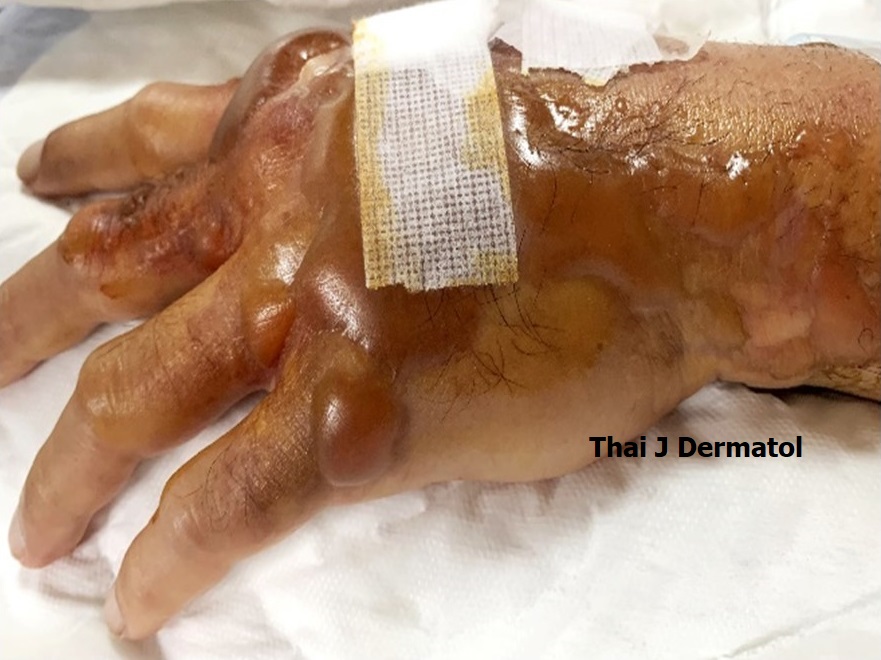Coma Blisters: A Case Report and Review of the Literature
Keywords:
Coma, blisters, histopathologyAbstract
Coma blister is an uncommon cutaneous manifestation classically described following conditions causing impaired consciousness, most frequently associated with drugs like overdoses of central nervous system depressants. However, they have also been described in association with other non-drug related cases of impaired consciousness and even in the setting of non-comatose conditions. They clinically present as tense blisters or bullae, occasionally resembling erosions and violaceous plaques, few in number over normal or edematous skin. They can occur on both dependent and non-dependent areas of the trunk and extremities. Coma blisters typically appear within 24 hours after the onset of unconsciousness and resolves spontaneously within 10-14 days. The exact pathophysiology behind coma blisters remains controversial as it cannot be fully explained by pressure effects nor by toxic effects of any specific medication and no relation to any underlying infection or autoimmune condition have been found so far. The hallmark and the most frequent histopathological feature of the lesion consists of necrosis of the eccrine gland. There is no specific treatment available for coma blisters. We herein present a 49- year-old Thai male who developed bullae on his extremity after prolonged impairment of consciousness without any predisposing associated substance that could cause the bullae. We also reviewed the literature on coma blisters in adult as well as in pediatric patients in terms of clinical characteristics and histopathological findings.
References
Beveridge GW, Lawson AAH. Occurrence of bullous lesions in acute barbiturate intoxication. Br Med J 1965;1:835-7.
Mehregan DR, Daoud M, Rogers R. Coma blisters in a patient with diabetic ketoacidosis. J Am Acad Dermatol 1992;27:269-70.
Piede J, Wallace E. Coma Bullae: Associations Beyond Medications. Mayo Clin Proc 2011;86:e5.
Sánchez Yus E, Requena L, Simón P. Histopathology of cutaneous changes in drug-induced coma. Am J Dermatopathol 1993;15:208-16.
Kato N, Ueno H, Mimura M. Histopathology of cutaneous changes in non-drug-induced coma. Am J Dermatopathol 1996;18:344-50.
Arndt KA, Mihm MC, Parrish JA. Bullae: a cutaneous sign of a variety of neurologic diseases. Invest Dermatol 1973;60:312-20.
Bosco L, Schena D, Colato C, Biban P, Girolomoni G. Coma blisters in children: case report and review of the literature. J Child Neurol 2012;28:1677-80.
Holden CA. Cutaneous bullae in coma due to poisoning: an association with deep seated ischaemic lesions of muscle. Anaesthesia 1977;32:554-5.
Basu A, Brown S, Kirkham N, Ramesh V, Leech S, Devlin A. Coma blisters in 2 children on anticonvulsant medication. J Child Neurol 2009;24:1021-5.
Reiley GD, Harrington CI. Positive immunofluorescence in bullous lesions in drug-induced coma. Br J Dermatol 1983;109:720–4.
Kim GW, Park HJ, Kim HS, et al. Bullae and sweat gland necrosis in the differential diagnosis for Vibrio vulnificus infection in an alcoholic patient. J Korean Med Sci 2011;26:450-3.
Chacon AH, Farooq U, Choudhary S, et al. Coma Blisters in Two Postoperative Patients. Am J Dermatopathol 2013;35:381-4.
Waring WS, Sandilands EA. Coma blisters. Clin Toxicol 2007;45:808-9.
Herschthal D, Robinson MJ. Blisters of the Skin in Coma Induced by Amitriptyline and Clorazepate Dipotassium. Arch Dermatol 1979;115:499.
Fogarty BJ, Khan K. Drug induced blistering and the plastic surgeon: a case of amitriptyline induced skin necrosis. Burns 1999;25:768-70.
Maguiness S, Guenther L, Shum D. Coma blisters, peripheral neuropathy, and amitriptyline overdose: A brief report. J Cutan Med Surg 2002;6:438-41.
You MY, Yun SK, Ihm W. Bullae and Sweat Gland Necrosis After an Alcoholic Deep Slumber. Cutis 2002;69:265-8.
Tsokos M, Sperhake JP. Coma Blisters in a Case of Fatal Theophylline Intoxication. Am J Forensic Med Pathol 2002;23:292-4.
Kim KJ, Suh HS, Choi JH, Sung KJ, Moon KC, Koh JK. Two cases of coma-associated bullae with eccrine gland necrosis in patients without drug intoxication Acta Derm Venereol 2002;82:378–80.
Ferreli C, Sulica VI, Aste N, et al. Drug-induced sweat gland necrosis in a non-comatose patient: a case presentation. J Eur Acad Dermatol Venereol 2003;17:443–5.
Keng M, Lagos M, Liepman MR, Trever K. Phenobarbital-Induced Bullous Lesions in a Non-Comatose Patient. Psychiatry 2006;3:65-9.
Rocha J, Pereira T, Ventura F, Pardal F, Brito C. Coma Blisters. Case Rep Dermatol 2009;1:66–70.
Muirhead T, Rudner E, Lim HW. A case of coma blisters in a non-pressure dependent distribution. J Am Acad Dermatol 2011;64 Suppl 1:AB95.
Branco MM, Capitani EM, Cintra ML, Hyslop S, Carvalho AC, Bucaretchi F. Coma blisters after poisoning caused by central nervous system depressants: Case report including histopathological findings. An Bras Dermatol 2012;87:615-7.
Agarwal A, Bansal M, Conner K. Coma blisters with hypoxemic respiratory failure. Dermatol Online J 2012;18:10.
Wiegand TJ, Gorodetsky RM, Peredy TR. Coma Blisters in the Setting of Quetiapine Overdose: Case Report and Review of Literature. Asia Pac J Med Toxicol 2013;2:153-6.
Asokan N, Binesh VG, Andrews AM, Jayalakshmi PS. Bullous Lesions, Sweat Gland Necrosis and Rhabdomyolysis in Alcoholic Coma. Indian J Dermatol 2014;59:632.
Chang KS, Su YJ. Coma blister in nontraumatic rhabdomyolysis. Am J Emerg Med 2016;34:1324.e1-2.
Ruiz-Rivero J, Pulido-Perez A, Suarez-Fernandez RM. Coma blisters with deep soft tissue involvement after drug overdose. Int J Dermatol 2017;56:881-3.
Setterfield JF, Robinson R, MacDonald D, Calonje E. Coma-induced bullae and sweat gland necrosis following clobazam. Clin Exp Dermatol 2000;25:215-8.

Downloads
Published
How to Cite
Issue
Section
License
เนื้อหาและข้อมูลในบทความที่ลงตีพิมพ์ในวารสารโรคผิวหนัง ถือเป็นข้อคิดเห็นและความรับผิดชอบของผู้เขียนบทความโดยตรงซึ่งกองบรรณาธิการวารสาร ไม่จำเป็นต้องเห็นด้วย หรือร่วมรับผิดชอบใดๆ
บทความ ข้อมูล เนื้อหา รูปภาพ ฯลฯ ที่ได้รับการตีพิมพ์ในวารสารโรคผิวหนัง ถือเป็นลิขสิทธิ์ของวารสารฯ หากบุคคลหรือหน่วยงานใดต้องการนำทั้งหมดหรือส่วนหนึ่งส่วนใดไปเผยแพร่ต่อหรือเพื่อกระทำการใดๆ จะต้องได้รับอนุญาตเป็นลายลักอักษรจากบรรณาธิการวารสารโรคผิวหนังก่อนเท่านั้น


